[ Contents Vol 5, 1989 ] [ QJER Home ]
RESEARCH REPORTS
The purpose of this section is to summarise information from recently completed research and evaluation studies in Queensland.
Intending contributors should forward a short abstract of their work, together with relevant biographical data, to: The Editor, Queensland Researcher, Research Services, Queensland Department of Education, PO Box 33, North Quay Q 4002.
| Title: | A Review of the Research Literature on Students' Attitudes to Mathematics |
| Authors: | J. Dungan and G. Thurlow |
| Institution: | Research Services, Division of Curriculum Services, Department of Education, Queensland |
| Date: | January, 1989 |
INTRODUCTION
What can research tell educators about the attitudes of school students to mathematics? Teachers are often encouraged to ensure that students develop positive attitudes to subjects, and learning in general, as well as acquire knowledge and skills. For example, the new Years 1 to 10 Mathematics Syllabus in Queensland specifically emphasises affective outcomes among its goals, such as the development of persistence and confidence in doing mathematics.
As part of an evaluation of the Queensland Mathematics Syllabus, a review of published research into school students' attitudes to mathematics was carried out. The findings of that review are summarised here.
SCOPE OF THE REVIEW
In defining the scope of the review, the term 'attitudes to mathematics' referred to students' responses which range from general liking, to perceptions of particular aspects of mathematics. Literature on research which related to both primary and secondary students and which was conducted since the late 1960s has been included. Over 30 papers, reports or articles have been reviewed.
The usefulness and importance of mathematics
The research suggests that students regard mathematics as a useful and important subject. Younger students see it as useful for their everyday lives while older students perceive it as important for future employment or higher education.
Students' liking of mathematics
Studies which have asked students to compare mathematics with other subjects revealed conflicting results. Some studies found that students in certain age groups rate mathematics highly compared to other subjects, but other studies found the opposite. It does appear, however, that older students tend to dislike mathematics and often find it difficult. Factors which have been identified as influencing students' liking of mathematics include:
- their perceptions of how well they understand the subject;
- the extent to which they experience new activities and topics;
- their perceptions of being successful at the subject; and
- their liking for their mathematics teacher.
FINDINGS
The following general findings are summarised from the studies reviewed. Findings from any one study do not necessarily apply to other settings. Some trends, however, are common from a number of studies conducted in quite different settings.
Factors which influence students' disliking of mathematics include:
- their perception of mathematics as hard work;
- the reviewing of previous years' work at the start of the school year;
- repetition of aspects of topics covered in previous years;
- homework; and
- the daily, unchanging routine of some mathematics classes.
The association between attitudes and achievement
Little evidence was found that favourable attitudes lead to higher achievement. Some researchers suspect that a reciprocal relationship exists between the two variables, with achievement and attitudes affecting each other.
The impact of alternative curricula and teaching approaches
There is uncertainty regarding the effect of alternative curriculum and teaching approaches on student attitudes. Studies involving experimental methods of teaching, for example enrichment activities, laboratory work, micro-teaching, and individualised instruction, did not find such methods to improve student attitudes more than traditional methods. Similar conclusions were obtained in a study which compared a 'traditional' and a 'modem' syllabus. These studies have been criticised on the grounds that the instruments to detect changes in attitudes were inappropriate and that more time was needed for the benefits of the methods or the syllabus to be realised. Other studies revealed differences, but for certain groups of students. If alternative curricula or teaching methods are associated with improved student attitudes, it may take some years before the improvements are substantial and then they may occur for only certain groups of students.
The association between teacher attitudes or qualities and student attitudes
Some evidence suggests that teacher attitudes or qualities are associated with attitudes to mathematics in older and more intelligent students. Teacher encouragement was found to influence students' selection of mathematics courses in secondary school.
The effect of age on student attitudes
One of the most consistently reported relationships identified in the research literature is between age or Year level and attitudes. The findings suggest that young students generally have stable, positive attitudes to mathematics, but by the age of 11, their attitudes become less favourable. This trend seems to continue through the early years of secondary school until, about the age of 14, when attitudes again stabilise.
The effect of gender
There were conflicting findings regarding the relationship between student attitudes and gender. One recent study showed that boys and girls had different attitudes to certain topics in mathematics. Although an association between gender and student attitudes probably exists, the influence of gender may be less pronounced than the effect of other variables such as achievement or age.
CONCLUSION
The major conclusion of the review is support for teaching which:
- tries to make mathematical experiences interesting or challenging;
- gears mathematics classes towards students' interests and encouraging student expression of opinions;
- introduces new mathematical topics as often as possible;
- attempts to make the revisiting of mathematical topics new, different or challenging in some way;
- avoids a review of work done in previous years at the start of the school year;
- presents work done previously in new contexts; and
- avoids repetition of aspects of mathematical topics.
The review tentatively concludes that, subject to certain conditions holding, the Years 1 to 10 Mathematics Syllabus could produce some, but limited, improvement in students' affects. Improvement might be more pronounced for groups of older students after many years of exposure to programs in harmony with the Syllabus.
FURTHER INFORMATION
Limited copies of the report, "A Review of the Research Literature on Students' Attitudes to Mathematics", are available from the authors, Research Services, Department of Education, Queensland, PO Box 33, North Quay, 4002.
*********
| Title: | A Summary of Results on Process Skills and Science Concepts for Primary Pupils in Queensland |
| Author: | N. Cranston*
*Officers of Research Services and Curriculum Services have made various contributions to the investigation discussed in this report. |
| Institution: | Research Services, Division of Curriculum Services, Department of Education, Queensland |
| Date: | December 1988 |
An investigation into pupils' learning of science in primary schools was carried out at the end of 1987 by the Research Services Branch of the Queensland Department of Education. The investigation involved Year 5 and Year 7 pupils from almost 90 schools across the State. Pupils completed tests of Science Concepts and Process Skills, and questionnaires on Attitudes and Classroom Practices. Teachers of pupils in the survey provided additional information.
Introduction
This paper summarises some of the general results of pupils' performances in science concepts and process skills. The results reported include summaries of some of the broad performance data (as mean scores) and comments on variations in the data, as well as performance information across the concept and process skill sub-categories. The paper concludes with some general statements about performance in the areas of concepts and process skills.
The Displays present mean scores for concepts and process skills (and sub-categories of these) for each Year level. In some cases, mean scores are also presented on the basis of pupil gender and school location. The length of the horizontal bar represents the range of scores for about 70 per cent of the population (being one standard deviation on either side of the mean), and gives an indication of the variability of scores. The mean score is represented by the heavy vertical line.
(Displays are examples only from a larger set of possibilities.)
Overview
The overall mean scores for pupils across the whole State were analysed according to school, location and pupil gender at each Year level for concepts and process skills. These are summarised in Displays 1 and 2.
The following observations can be made from the data:
- The overall mean scores of pupils at both Year levels were higher for process skills than for concepts.
- Greater variability in scores occurred for the process skills-compared with concepts at the Year 7 level. At the Year 5 level, greater variability occurred for concepts.
- At both Year levels, only very minor differences in mean scores for either the concepts or process skills were evident for boys compared with girls.
Display 1: Concepts and Process Skills Mean Scores: Year 5
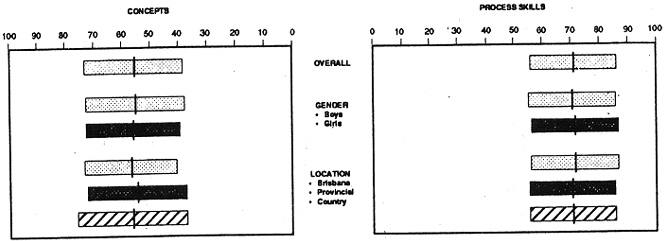
- At the Year 5 level, some minor differences in mean scores in terms of school location were evident. For concepts, the lowest score occurred for pupils located in Provincial schools, with similar but slightly higher scores for pupils in Brisbane and Country schools. For process skills, the highest score occurred for pupils in Brisbane schools, with similar but slightly lower scores for pupils in Provincial and Country schools.
- Again, at the Year 7 level, only some minor differences in mean scores in terms of school location were evident. For example, for concepts, the lowest score occurred for pupils in Brisbane schools with similar but slightly higher scores for pupils in Provincial and Country schools.
- For Year 5, slightly less variability in scores for concepts occurred for pupils in Brisbane schools compared with those in Provincial and Country schools. Similar variability in scores occurred for process skills in terms of school location.
- For Year 7, similar variability in scores occurred for concepts in terms of school location. Slightly greater variability in scores for process skills occurred for pupils in Country schools compared with those in Brisbane and Provincial schools.
Display 2: Concepts and Process Skills Mean Scores: Year 7
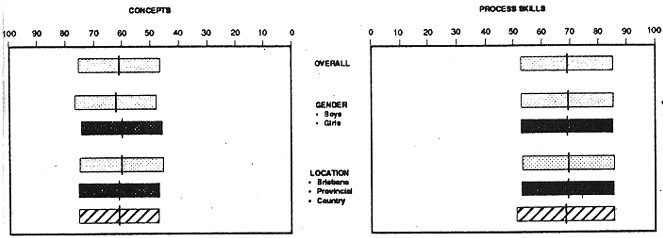
Concepts
The five sub-categories of science concepts on which performance information is available are life, energy, matter, earth and space. Pupils' mean scores on these sub-categories at each Year level are summarised in Display 3. The following observations can be made from the data:
- For Year 5, the range of mean scores across the sub-categories was large, from lowest, earth, to highest, life. In general, the scores were highest for life, energy and matter, with scores on earth and space considerably lower. Differences in the variability of scores within each of the sub-categories are also noteworthy, with greatest variability for space and the least for life.
- For Year 7, the range across sub-category mean scores was similarly large. Mean scores were highest for life and energy with energy the higher of these. The score for earth was considerably lower than all others. As for Year 5, differences in variability across the five sub-categories are evident, with greatest variability occurring for space and the least for life and matter.
Two additional observations of note which can be drawn from data not displayed here are:
- At the Year 5 level, similar mean scores for boys and girls occurred for life, energy and earth. Minor differences in mean scores were recorded for matter (girls higher than boys) and space (boys higher).
- At the Year 7 level, similar mean scores for boys and girls occurred for life, matter and earth. The mean score for energy for boys was higher than for girls. A minor difference for space (boys higher) was also noted.
Display 3: Concept Mean Scores In Sub-Categories

Process Skills
The four sub-categories of process skills on which performance information is available are collecting data, organising data, generating knowledge and manipulating and interpreting knowledge. (These sub-categories were arrived at by clustering the individual processes. The process of communicating was assumed to be involved in any test of the other processes.) Pupils' mean scores on these sub-categories at each Year level are summarised in Display 4.
The following observations can be made from the data:
- Similar overall patterns of mean scores are evident for both Year levels.
- For Year 5, the range in mean scores across the sub-categories was large with the mean scores on collecting data and manipulating and interpreting knowledge the highest, and generating knowledge the lowest. Differences in the variability of scores within each of the sub-categories was also marked, with variability for organising data the greatest, and collecting data the least.
- For Year 7, the range of scores across the sub-categories was similarly large. The mean scores were highest for collecting data and organising data, and lowest on manipulating and interpreting knowledge and generating knowledge. Sub-category variability was also disparate with generating knowledge the greatest and collecting data the smallest.
A further observation from data not displayed is that at both Year levels, mean scores for boys and girls were similar.
Display 4: Process Skills Mean Scores in Sub-Categories

Conclusion
In summary, the following statements about the performance of primary pupils in this science investigation can be made:
- Mean scores on process skills were higher than those on concepts at both Year levels.
- The differences in mean scores across sub-categories was marked at both Year levels for both concepts and process skills. Variability within sub-categories was also differential.
- Some minor differences in scores for concepts and process skills in terms of school location were evident.
- Few boy/girl differences in mean scores were noted.
***
Background information on the investigation can be found in the following Queensland Department of Education publications:
- An Investigation into Pupils' Learning of Science in Primary Schools: A Progress Report, Cranston, N., 1988.
- An Overview of an Investigation into Pupils' Learning of Science in Primary Schools: Research Bulletin, February 1988.
**********
| Title: | A Summary Report on a Recent Survey of Bicycle Helmet Wearing by Students in Years 1 to 12 |
| Authors: | Michael Byrne and Christine Grieve |
| Institution: | Research Services, Division of Curriculum Services, Department of Education, Queensland |
| Date: | December 1988 |
BACKGROUND
In 1988, a survey was conducted to gather information regarding bicycle helmet use in students in Years 1 to 12 in Queensland schools. Data were gathered by Year level and gender from a representative sample of 111 Queensland schools attended by approximately 31,000 students. The schools provided information on the number of students riding bicycles to school, whether or not the cyclists wore helmets and whether or not the helmets worn conformed to the approved Australian Standard. Schools were asked a number of questions about various helmet schemes. Space was provided for additional comments on the survey.
A report on the major findings has been prepared by Research Services Branch titled "Survey of Bicycle Helmet use by Students in Queensland State Schools - 1988". This report provides a brief pictorial summary of these findings.
MAJOR FINDINGS
Students riding bicycles to school
Although the majority of students travel to school by modes of transport other than bicycle riding, a sizeable minority of students (24 per cent) do ride bicycles to school. Cyclists are located in each Year level, increasingly so up to Year 8. From Year 9 on the proportion of students riding to school gradually decreases.
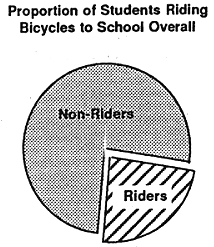
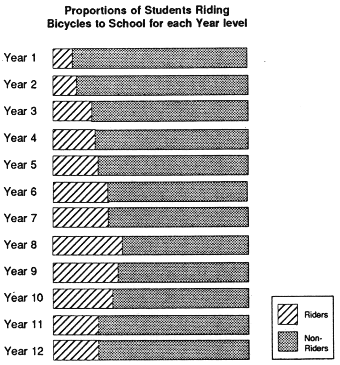
| Year Level | Students Not Riding Bicycles to School | Bicycle Riders Not Wearing Helmets | Bicycle Riders Wearing Approved Helmets | Bicycle Riders Wearing Non Approved Helmets |
| Year 1 | 90% | 6% | 3% | 0% |
| Year 2 | 87% | 8% | 5% | 0% |
| Year 3 | 80% | 12% | 8% | 1% |
| Year 4 | 78% | 14% | 70% | 1% |
| Year 5 | 76% | 16% | 8% | 0% |
| Year 6 | 71% | 21% | 8% | 0% |
| Year 7 | 71% | 23% | 6% | 1% |
| Year 8 | 64% | 33% | 3% | 0% |
| Year 9 | 67% | 31% | 1% | 0% |
| Year 10 | 69% | 30% | 1% | 0% |
| Year 11 | 76% | 24% | 1% | 0% |
| Year 12 | 76% | 23% | 0% | 0% |
| Total | 76% | 19% | 4% | 0% |
Overview
Overall, about one-quarter of students ride bicycles to school. Of these riders, only 20 per cent wear helmets which are, almost without exception, of an approved design. The patterns of bicycle riding and helmet use presented above were very similar for males and females and for schools with student enrolments of 300 or more, and those with enrolments of 300 or less.
Helmet use
A minority of bicycle riders wear helmets. The survey found that in the early years of schooling (Years 1 to 3), almost 40 per cent of cyclists wear helmets, but this proportion falls from Year 4 on, with approximately 20 per cent of students wearing helmets by Year 7. By comparison, only about seven per cent of riders wear helmets in Year 8 and the proportion continues to decline through to Year 12 where less than two per cent of riders wear helmets.
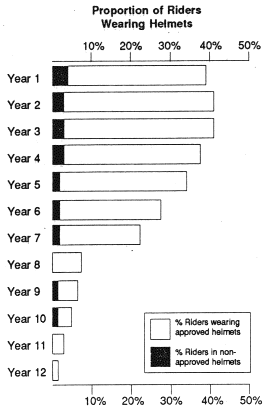
Are helmets of the approved design?
With few exceptions, helmets worn are of the approved design, manufactured according to the appropriate Australian Standard.
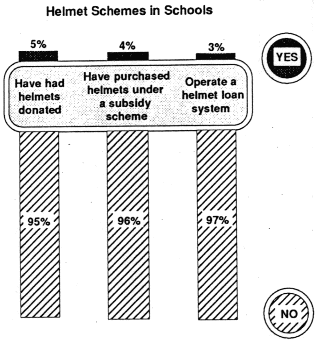
Helmet schemes in schools
Few schools have had helmets donated or have purchased helmets through a subsidy scheme. Only a small number of schools operated a helmet loan scheme. Overall, about five per cent of schools had a helmet scheme of some form.
Comments from schools about the survey
A number of schools provided comments in relation to bicycle riding and helmet use. The three main areas in which comments were made were: brief descriptions of the various approaches of schools to promoting helmet use; aspects of peer pressure on helmet wearing; and parental attitudes towards helmet wearing.
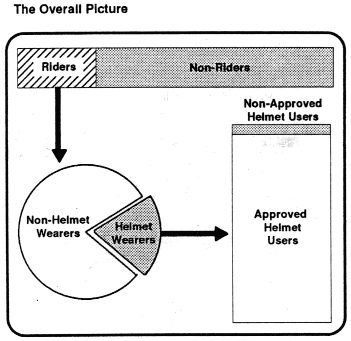
In Summary
This study indicated that the majority of students in Queensland do not ride bicycles to school. Of those who do ride bicycles, very few wear safety helmets.
FURTHER INFORMATION
- Copies of the full report are available from Research Services Branch, Division of Curriculum Services, Department of Education, PO Box 33, North Quay, Q 4002.
- Barry Collis, Co-ordinator, Road Safety Education, can be contacted about aspects related to bicycle safety and helmet use.
- Questions concerning the Bicycle Helmet Survey may be directed to Michael Byrne, Research Services Branch.
| Please cite as: QIER (1989). Research reports 5(1). Queensland Researcher, 5(1), 15-28. http://www.iier.org.au/qjer/qr5/research-repts5-1.html
|
[ Contents Vol 5, 1989 ] [ QJER Home ]
Created 24 Mar 2007. Last revision: 24 Mar 2007.
URL: http://www.iier.org.au/qjer/qr5/research-repts5-1.html










